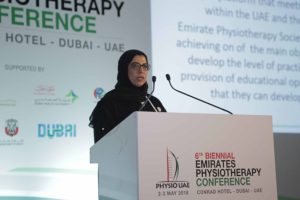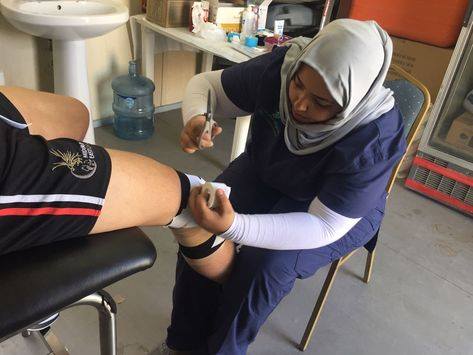Very much in the centre of our familiar flat world map is a small country with a coastline at the north east of the Arabian Peninsula on what we call the Arabian Sea and other may know as the Persian Gulf. In fact, this area has been long fought over, divided and carved up arbitrarily even before the advent of oil and gas was found. The profession of Physiotherapy has only had several decades of development in what is now, since 1971, been known as the United Arab Emirates (UAE). The UAE is made up of seven Emirates (city states), Abu Dhabi (Capital), Dubai, Sharjah, Ajman, Fujairah, Ras Al Khaimah and Um Al Quwain. The physiotherapists who work here have come from over 50 countries and brought their history and traditions with them. This is the joy of practicing in the Gulf where the expatriate community is so varied and where the local people have many rich traditions but have also managed to rapidly develop the health and education sector in the last 50 years.

Where is the UAE?
The history of medicine and in particular, physical therapies in this region is however, very old and when the modern profession of Physiotherapy was introduced into the developing public health system of the 70’s, local people were familiar with the use of heat and cold for healing. They had been cared for by traditional healers using hijama (cupping), kawiy (cautery/ branding), hydrotherapy and bone setting procedures since persons first settled on the oases of this region and dived for pearls off the coastline. Physiotherapists, particularly in the public sector have come mostly from Britain, India, Egypt and the Philippines. Physiotherapists in the UAE work not only in its large public hospitals but also in smaller government health centres, in private practices, in the police, the armed forces, large industries and in its many sports clubs.
Mrs Soudagar, one of the original Physiotherapy leaders in the UAE came to Dubai from Bombay (Mumbai) in the late 70s to manage the new department at Rashid Hospital. Physiotherapy practise was heavily influenced by British traditions and Mrs Soudagar herself has spent two years at Ostwestry at the Robert Jones and Agnes Hunt Hospital in the UK training as a physiotherapist, supported by the Indian government in recognition of her skills. Mrs Soudagar, now in her mid 80s recalls with fondness the many conversations she had with both colleagues and patients in the early days to explain what physiotherapists did. A typical response she offered was; “Well you know what doctors do and you know what nurses do, well, we do everything else so that nothing is missed” Apparently the local people were generally happy with this explanation of her role. In many ways that was Mrs Soudagar’s approach, she would take on any challenge and prove that the physiotherapy role was diverse and needed in many areas. Very early in her tenure at the new Dubai Hospital, Mrs Soudagar set up a children’s physiotherapy service for families whose children had developmental disabilities. One of those physiotherapists originally from India was sent to the Bobath Centre in London to study and brought back with her the latest ideas and competencies to support the children of Dubai. Today, both Dubai and Abu Dhabi have highly trained physiotherapy staff working in the very specialised area of the neonatal intensive care units and support for children with disabilities in the public and private sector follows a multidisciplinary and family centred model informed by the latest evidence.
When the author began working as a physiotherapist in Dubai in the mid 90s, the formal process of professional licensing and regulation was still developing. Since 2010, Physiotherapists have to sit a licensing exam in Dubai and in Abu Dhabi for practise in the other 6 Emirates. Working at Dubai Centre for Special Needs (DCSN) with physios from the US, Denmark, Finland, Sweden, Philippines, India and Sri Lanka supported us to explore our common understanding of our practise and also learn from each other different ways of seeing and understanding our patients and families. When I joined DCSN, I was so excited to work with a multidisciplinary team and also to practise collaborative goal setting with families using individual education plans. The centre’s practise was really at the forefront of cultural change regarding perceptions of persons with disability. Still today disability is misunderstood but the UAE and its physiotherapy community have worked tirelessly to improve understanding and inclusion of persons with disabilities.
Being part of a developing health system that is well resourced has supported the evolution of physiotherapy practise and certainly in private practise first contact access is now an option. In the public sector, physiotherapy department were and still are mostly led by physical medicine specialists. This has been a challenging relationship as many physiotherapists found their autonomous practise mitigated by a medical colleague directing treatment plans.

Mrs Amal Al Shamlan 1st Emirati (Local) Physiotherapist
The first Emirati physiotherapist, Mrs Amal Al Shamlan graduated from the College of Allied Health Sciences at Kuwait University in 1988 and began practise at Dubai Hospital under Mrs Soudagar’s leadership in 1989. Amal has gone on to teach in the first local physiotherapy program at the University of Sharjah, to be instrumental in forming the Emirates Physiotherapy Society (EPS) in 2004 and to lead and manage large public rehabilitation centres for children and adults. Amal was also one of the first Emirati physiotherapist to earn her master’s degree and her study on the public physiotherapy services in Dubai offers a valuable snapshot of practise during the mid 2000s.
Emirates Physiotherapy Society (EPS) was formally recognised by the World Confederation of Physical Therapy at the congress in 2007. EPS was represented by Amal and Mrs Naima Saleh, another strong advocate for the development of the profession in the UAE.
Since 2006, EPS has hosted the biannual Emirates Physiotherapy Conference, and this has attracted international speakers and raised the profile of the profession nationally. This year, it was EPS who hosted the first totally virtual conference in Dubai, using a mostly zoom enabled platform with several hundred participants listening to, and interacting with, both international and local speakers. EPS has also been a great advocate for raising the profile of the profession in the region and to that end has in the last decade signed agreements of collaboration to form an Arab Federation with professional bodies from countries including Kuwait, Saudi Arabia and Lebanon.
The first physiotherapy programs opened at the University of Sharjah and the Gulf Medical University in 2000. Both universities initiated a Master of Physiotherapy program last year.
A third program is offered in Al Ain and in Abu Dhabi at Fatima College. The 3 programs are 4 year Bachelor degrees.
The development of the profession in the late 70s and through the 80s has not been documented. We are presently conducting a project to explore this period to better understand the origins of practise in the UAE and to learn more about the influences of the various communities of physiotherapists that make up the rich mosaic that is the UAE. If you have practised physiotherapy in the UAE and would like to share your story with others, please contact me, Susan Waller by email at waller.susan@gmail.com

